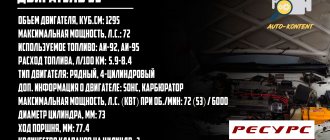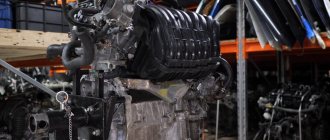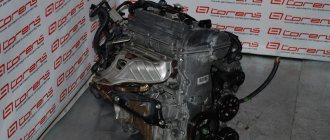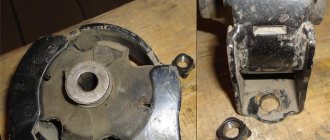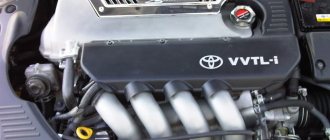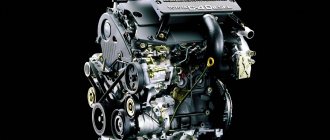Toyota Rav 4 has always positioned itself as a compact crossover, more intended for young people. Actually, the decoding of the abbreviation RAV speaks of the main idea laid down by the manufacturer in the basis of the Japanese car - Recreational Active Vehicle 4 Wheel Drive. Which in translation means – an all-wheel drive vehicle for active recreation. It is the number 4 that indicates that the torque from the engine in this car is transmitted to all four wheels. RAV 4 has been a leader in its segment for several years.
The first generation was released back in 1994. At that time, it was a truly unique car: a 3-door or 5-door layout, independent wheel suspension and a load-bearing body structure. Drivers leading an active lifestyle began to purchase a crossover with great enthusiasm. Over the years, the model has not lost its relevance; on the contrary, it has become even more popular. Today the fourth generation of the model is successfully rolling off the assembly line. And already in 2021, Toyota will begin production of the 5th generation of cars. In this article we will talk about the service life of the Toyota Rav 4 engine of the very first and latest generations.
Line of power units
Toyota does not hide the fact that each new generation of the model is mainly intended for the young category of drivers aged 25-30 years. A bold statement, one might say that it is even a challenge. However, the Japanese do not go back on their words at all - they are constantly offering new configurations. The line of Rav 4 power units is updated with enviable frequency, as is the design, interior and functionality of the crossover. Initially, the model was equipped with a 2.0-liter 3S-FE engine with a power of 135 horsepower; after some time, a modification of the 3S-GE engine with 178 horsepower appeared. Both engines are combined with a manual or automatic transmission.
Performance characteristics of 3S-FE:
- Engine type: 4-cylinder DOHC;
- Fuel used: AI-92, AI-95;
- Cylinder diameter: 82 mm;
- Number of valves: 16;
- Valves per cylinder: 4;
- Potential resource: 400 thousand km.
It is worth saying that Toyota has always had not only all-wheel drive, but front-wheel drive modifications that found buyers in North America and Japan. Already with the release of the 2nd generation, the Japanese are offering new power plant options: 2-liter 1AZ-FE, 1AZ-FSE with 150 horsepower, 2.4-liter 2AZ-FE and 2AZ-FSE with a stated power of 160 hp. The two-liter diesel D-4D, which is characterized by good traction, also finds its buyers.
Characteristics of 1AZ-FE:
- Engine type: 4-cylinder DOHC;
- Fuel used: AI-95;
- Environmental standard: Euro-5
- Cylinder diameter: 86 mm;
- Potential resource: 400 thousand km.
But, perhaps, the Japanese offer the greatest variety with the release of the 4th generation Toyota Rav 4. At this time, two new turbodiesels of 2.0 and 2.2 liters immediately appeared. The 2.4 engine, which has gone down in history, is successfully replacing the structurally improved 2.5-liter engine with a capacity of 180 horsepower. As for the popularity of certain types of power plants, the 2.0-liter gasoline engine 1AZ-FE is most loved by domestic drivers - it is unpretentious, reliable, and resource-intensive. The 2.2-liter turbodiesel, which appeared in the fourth generation of the crossover, is also gaining popularity.
All-wheel drive Toyota RAV4
The Dynamic Torque Control 4WD (DTC) system, which is a more advanced version of the Active Torque Control (ATC) system, is responsible for distributing forces between the wheels of the Toyota RAV 4 crossover. The all-wheel drive scheme provides for the absence of a center differential, and the function of connecting the rear axle is assigned to an electromagnetic clutch located in front of the rear axle gearbox. By default, torque is distributed between the axles in a ratio of 100:0, i.e. all traction is sent to the front wheels. If slippage or understeer occurs on turns, the proportion changes up to 50:50.
In Sport mode, activated via a button, the rear axle engages with the slightest turn of the steering wheel and the force begins to be distributed in a 90:10 ratio. In the future, if the system deems it necessary, the ratio will change (the rear wheels can receive a maximum of 50% of the torque).
The 4WD Lock button turns on the locking forcibly, fixing the division of traction between the axles equally – 50:50. In this mode, the drive operates at speeds of up to 40 km/h and then switches to standard mode.
Nominal and actual motor life
A timing chain is used as a timing drive in all crossover gasoline engines. Its service life is noticeably higher than that of other representatives of this car segment - 150 thousand km. Owners of Rav 4 note that after this mark its stretching begins, therefore, it is not recommended to operate the car on the same chain for longer than 150,000 km. With high-quality and timely maintenance, the two-liter naturally aspirated 1AZ-FE engine covers at least 300 thousand km. Cases when this engine traveled 400 and even 500 thousand kilometers are not isolated. There is considerable potential in this modification of the power plant.
Another 2.0-liter naturally aspirated engine, the 3S-FE, has approximately the same resource. This is a fairly reliable power unit, an exact copy of the 2.2-liter engine from the Toyota Camry, but with one difference - it does not have balance shafts. The motor works perfectly on the AI-92, its valves do not suffer in the event of a timing drive break. Along with the drive, the roller and pump are also replaced. The main thing is to respond to the slightest malfunction in a timely manner, as well as replace consumables with high-quality analogues or original parts.
The 2.2-liter AD-FTV turbodiesel is equipped with a belt drive. As a rule, the engine does not cause any special problems during the first 250-280 thousand kilometers. Afterwards, you may need to replace the injectors, which are seriously affected by low-quality fuel. Often, owners have to clean the VRV and EGR vacuum valve ahead of schedule. In some cases, these elements fail prematurely. Replacing them costs 30-50 thousand rubles. Potentially, the 2.2-liter engine is capable of traveling 300 thousand km on Russian roads. To extend the service life of the unit, it is recommended to clean the injectors every 10-15 thousand kilometers.
Reviews from Toyota RAV 4 owners
The 2.5-liter gasoline engine appeared relatively recently. It is not yet possible to say unambiguously what its resource is in practice. However, there is no doubt about the high build quality of the power plant. 2AR-FE has proven itself to be the best since it was installed on the Toyota Camry. It is structurally perfect, has no obvious shortcomings and chronic “sores”. Perhaps the only weakness of the modification is that the 2AR-FE cannot be overhauled. On the other hand, with systematic maintenance, the engine can operate for 400 thousand kilometers. The owner's reviews will provide a comprehensive answer about the service life of the Toyota Rav 4 engine.
Engine 2.0 (1AZ-FE, 3S-FE, 3ZR-FAE)
- Kirill. Novokuznetsk. In 2002, I purchased a Toyota RAV 4, generation 2, 1AZ-FE engine. Now the odometer shows 280 thousand km. So far, the engine feels good: it starts easily, I don’t add oil, and there’s no black smoke coming out of the exhaust pipe. I always adhered to the maintenance regulations and only filled in the recommended oil. The only thing I don't like is the cylinder block of the installation. It is made of aluminum, and cast iron sleeves are pressed into it. It is almost impossible to carry out a capital project, although some craftsmen take on such work and give a guarantee of 20 thousand km, which, of course, is ridiculous. I hope the car will last another 100-120 thousand; crossovers cost 400,000 with such an engine.
- Sergey, Kazan. Many people say that a major overhaul on 1AZ-FE is impossible, so I hasten to dispel the myths. In 2010, I got a Rav 4, 3rd generation with a 2.0-liter “dead” engine. The car was produced in 2007, and at that time the mileage was 50 thousand kilometers. In general, the previous owner never changed the oil at all, plus the engine constantly overheated. 1AZ-FE is terribly afraid of overheating, no matter what the mileage is. In general, I bought the car at a good price and decided to repair the engine. What we did: grinding the cylinder head, replacing parts of the connecting rod and piston group and rings, cleaning the crankcase ventilation. The repairs cost 70 thousand rubles. Now the mileage is already 200 thousand kilometers, the flight is normal.
- Yuri, Moscow. I have a Toyota RAV 4 3S-FE, 1st generation, 1998. Now the car is already 20 years old. During this time, 400,000 km were covered. No major repairs were done. I know many who have already undergone the same modification for half a million and no matter what. This assembly is sensitive to engine oil quality. It’s not worth pouring anyhow. For 3S-FE engines produced before 1996, the recommended oil with a viscosity of 5W40 is best suited, and for those produced after 1996 - 5W30. You only need to pour a quality product. Chain resource – 150,000 km. The engine is of high quality, reliable, and the hassle of trifles begins only after crossing the 200,000 km mark.
- Albert, St. Petersburg. I have a Toyota 3ZR-FAE, a 2010 car. There are no complaints about the quality of the car. The power unit is pleasing; over 160,000 km of mileage it actually didn’t bother me at all. Requires only high-quality oil and fuel. “Maslozhor” did not notice, on average it consumes 8 liters per 100 km. There were problems only with the control unit, but in the end it was quickly resolved at the service center. Overall, another high-quality unit from Japanese engineers.
There is no doubt about the reliability and quality of naturally aspirated power plants of the Toyota Rav 4 with a displacement of 2 liters. Potentially, they can last half a million, and only because of a careless attitude towards motors and non-compliance with scheduled maintenance regulations, in most cases these motors exhaust their service life at the turn of 300 thousand km.
Engine 2.2 (2AD-FTV turbodiesel)
- Alexey, Novorossiysk. Toyota Rav 4, 2013, 2.2 liter turbodiesel, power 150 horsepower. Already covered 75 thousand km. There were no problems. You can get the most out of a diesel engine if you follow some rules. Replace the fuel filter every 30 thousand km, oil every 7-8 thousand km, fill only with the recommended one. Treat the turbine with care; after long trips, do not immediately turn off the engine, let it run for 10 minutes without load. This engine is picky about the quality of diesel fuel. Even one unsuccessful refueling can break the engine. At a service station they recently told me that the resource of a turbodiesel is quite long, but what exactly it is is anyone’s guess. No official data, only personal experience. I assume that 2AD-FTV is capable of passing 300-350 thousand.
- Vyacheslav, Tula. I bought the car in 2015, 2.2 liter turbodiesel. In three years I covered 60,000 km. I travel a lot, I went on a long trip around Russia. What can I say about the car and its engine? The crossover feels great at low revs, I especially like driving the Rav 4 along serpentine roads. It pulls well uphill, no problems. In terms of dynamics – playful and cheerful. The dealership said that with proper maintenance there will be no problems at all up to 200 thousand km. They recommended filling the Lukoy with ECTO diesel, saying that the engine would not experience any problems with it, and there would be no breakdowns in the fuel system. Let's see.
Owners of the turbodiesel modification note the high dynamic performance of the car. The diesel engine operates quietly and no extraneous sounds are heard into the cabin. At the same time, the engine is quite reliable - the actual service life of the Toyota Rav 4 2.2 liter engine is 300,000 km. The turbine is also well-made and operates uninterruptedly for 200,000 km, after which it may require minor repairs.
Engine 2.5 (2AR-FE)
- Anatoly, Kostroma. I used to drive a Toyota Camry, after which I decided to buy a Rav 4 with a new 2.5-liter 2AR-FE engine with an Aisin U760E gearbox. Crossover 4th generation, 2014 release. The 2AR-FE unit replaced the 2.4-liter 2AZ-FE, I recommend that everyone pay attention to the first engine when choosing. What can I say about its reliability? In four years, a little has been covered - 80 thousand kilometers. Its cylinders are cast from aluminum alloy - protect the engine from overheating. 2AR-FE is better than 2AZ-FE in all respects, and it has a longer service life. Experts say that it is quite possible to travel half a million on it; perhaps its only drawback is a weak chain. After 100 thousand km it requires replacement, I haven’t done it myself yet, but I’m already getting ready. Listen to the work of the “heart” of the car, if there is a knock, check the VVT drive.
- Ilya, Tyumen. Toyota RAV 4 2AR-FE can rightfully be called one of the most successful assemblies of recent generations. Firstly, the oil burner was completely eliminated; this engine consumes everything in moderation. Secondly, the problems with the notorious EGR valve have been corrected. Personally, in two years of using the crossover (I’ve been driving it since 2017) I haven’t experienced any problems. As for gasoline. There is good fuel in Russia; I myself know several good gas stations. The service life of the Toyota Rav 4 engine depends entirely on the owner. Some people can go 300-350 thousand km without the slightest intervention, while others manage to shut down the engine after 100 thousand kilometers.
- Vasily, Moscow. Today, without much difficulty, you can find companies that produce cast iron liners and press them into the 2AR-FE aluminum block. The Toyota RAV 4 2.5 has already covered 200,000 km. During this time, I only changed the chain and after 120 thousand km the catalyst went off. There were no more breakdowns. Naturally, I change consumables and purchase a lubricant recommended by the manufacturer. I refuel at Lukoil AI-95, as for me, it has the best fuel. It feels like the crossover will have at least as much time to go. And then you can carry out major repairs at your own risk.
The 2AR-FE power unit is quite good in terms of design and does not have any serious flaws or shortcomings. With high-quality service and due attention, it will definitely not let you down during the first 350 thousand kilometers.
About engines for Toyota RAV4
One of the most popular SUVs, Toyota RAV4, is at the first step in the SUV lineup from the Japanese manufacturer. However, nothing outstanding can be found under the hood of the Rav 4 - only standard 2.0-2.5 liter engines typical for cars of this class.
Engine Toyota 1ZZ-FE/FED/FBE 1.8 l
The 1ZZ family of engines was released in 1998, and replaced the outdated A-series engines. In particular, the 1ZZ replaced the 7A, but with a lightweight aluminum cylinder block and cast iron liners. The timing belt drive was replaced with a chain. The engines now have an IFGR system on the VVTi intake. Forged connecting rods were used, plus lightweight valves, and in general the engine turned out to be long-stroke and low-end, which is perfect for the North American market.
The most common shortcomings include oil wasting due to imperfect oil scraper rings, but after 2005 this disadvantage was removed.
The 1ZZ is also characterized by knocking and noise due to stretching of the timing chain drive.
Floating speed can be removed by washing the throttle valve block and the XX valve.
If vibration occurs, you need to pay attention to the rear cushion of the unit.
According to the manufacturer, the 1ZZ engine is not repairable, and its service life does not exceed 200 thousand kilometers. 4-
Engine Toyota 1AZ-FE/FSE 2.0 l
The Toyota AZ engine family appeared on the market in 2000 and replaced the “S” series.
In particular, the 1AZ-FE/FSE engine became the successor to the popular 3S-FE/FSE, but unlike its predecessor, it did not have many modifications.
The new engines have a lightweight aluminum BC, a VVTi variable inlet gas distribution system and an electronic throttle valve are installed, and the FSE modification uses direct fuel injection. To reduce the load on the liners, the cylinder axis was shifted relative to the crankshaft axis.
Toyota 1AZ-FE/FSE 2.0 is characterized by thread failures in the cylinder head mounting block.
Vibrations also often occur at idle, which is a feature of the motor.
If the engine is jerking, it's time to clean the throttle body and carbon deposits in the intake manifold.
Overheating is also typical for Toyota 1AZ-FE/FSE 2.0 versions for the Japanese market, which will entail loss of body geometry and replacement of the engine with a contract one. 4-
Engine Toyota 2AR-FE/FSE/FXE
The 2AR-FE power unit appeared in 2008 and replaced the 2.4-liter 2AZ-FE. The aluminum BC received thin cast iron sleeves, the crankshaft with 8 counterweights is shifted 10 mm towards the exhaust and uses two balancer shafts. Lightweight pistons received a floating pin.
The cylinder head with two shafts is mounted on a three-layer metal gasket and has hydraulic compensators. The IFGR system is used on two Dual-VVTi camshafts. The timing belt uses a single-row chain drive.
Due to the fairly good design of the 2AR-FE engine, the unit has no obvious illnesses or design features.
Sometimes the pump leaks and the VVTi clutch knocks when cold.
In general, the motor is disposable, but reliable. 4
Engine Toyota 2GR-FE/FSE/FXE/FZE 3.5 l
The 2GR power unit was developed in 2005 on the basis of the 4.0-liter 1GR to replace the 3MZ-FE, reducing the piston stroke to 83 mm. The aluminum BC received cast iron liners, a cylinder camber angle of 60 degrees, lightweight T-shaped pistons and forged connecting rods.
The engine uses a timing chain drive, hydraulic compensators and an IFGR system on Dual-VVTi shafts at the intake and exhaust.
Common malfunctions include oil leakage due to the rubber part of the oil tube, which quickly fails.
When starting, noise and cracking may be heard, which indicates a malfunction of the VVTi clutch and is considered a feature of the engine.
When the idle speed decreases, you need to clean the throttle valve.
In the first versions of the engine, the ignition coils quickly broke, and every 50-70 thousand kilometers the pump begins to leak. 4
| Engines | Toyota 1ZZ-FE/FED/FBE 1.8 | Toyota 1AZ-FE/FSE 2.0 | Toyota 2AR-FE/FSE/FXE | Toyota 2GR-FE/FSE/FXE/FZE 3.5 l |
| Production | Tianjin FAW Toyota Engines Plant No. 1 Toyota Motor Manufacturing West Virginia Shimoyama Plant | Kamigo Plant Shimoyama Plant | Kamigo Plant Toyota Motor Manufacturing Alabama | Kamigo Plant Shimoyama Plant Toyota Motor Manufacturing Alabama Toyota Motor Manufacturing Kentucky Toyota Motor Manufacturing West Virginia |
| Engine make | Toyota 1ZZ | 1AZ | 2AR | Toyota 2GR |
| Years of manufacture | 1998-2007 | 2000-present day | 2008-present | 2005-present day |
| Cylinder block material | aluminum | aluminum | aluminum | aluminum |
| Supply system | injector | injector | injector | injector |
| Type | in-line | in-line | in-line | V-shaped |
| Number of cylinders | 4 | 4 | 4 | 6 |
| Valves per cylinder | 4 | 4 | 4 | 4 |
| Piston stroke, mm | 91.5 | 86 | 98 | 83 |
| Cylinder diameter, mm | 79 | 86 | 90 | 94 |
| Compression ratio | 10 | 9.6 9.8 10.5 11 | 10.4 (2AR-FE) 12.5 (2AR-FSE) 13.0 (2AR-FXE) | 10.8 11.8 12.5 13 |
| Engine capacity, cc | 1794 | 1998 | 2494 | 3456 |
| Engine power, hp/rpm | 120/5600 140/6400 143/6400 | 145/6000 150/5700 150/6000 152/6000 | 154/5700 171/6000 177/6000 181/6000 | 249/6000 270/6200 272/6200 278/6000 278/6200 280/6400 295/6300 309/6400 311/6600 313/6000 315/6400 318/6400 328/6400 350/7000 360/6400 |
| Torque, Nm/rpm | 165/4400 171/4200 171/4200 | 190/4000 193/4000 193/4000 200/4000 | 187/4400 226/4100 221/4200 232/4100 | 317/4800 336/4700 333/4700 360/4600 346/4700 350/4600 362/4700 377/4800 362/4700 335/4600 377/4800 380/4800 400/4800 400/4500 498/3200 |
| Fuel | 92 | 95 | 95 | 95 |
| Environmental standards | Euro 4 | Euro 5 | Euro 5 | Euro 5 |
| Engine weight, kg | 135 | 131 | ~150 | 163 |
| Fuel consumption, l/100 km (for Celica) - city - highway - mixed. | 10.3 6.2 7.7 | 11.4 7.3 9.8 | 11.0 5.9 7.8 | 14.3 8.4 10.6 |
| Oil consumption, g/1000 km | up to 1000 | up to 1000 | up to 1000 | up to 1000 |
| Engine oil | 5W-30 10W-30 | 0W-20 5W-20 | 0W-20 0W-30 0W-40 5W-20 5W-30 5W-40 | 5W-30 |
| How much oil is in the engine | 3.8 | 4.2 | 4.4 | 6.1 |
| Oil change carried out, km | 10000 (better 5000) | 10000 (better 5000) | 7000-10000 | 10000 (better 5000) |
| Engine operating temperature, degrees. | ~95 | — | — | — |
| Engine life, thousand km - according to the plant - in practice | n.d. ~200 | n.d. 300+ | — 300+ | n.d. 300+ |
| Tuning - potential - without loss of resource | 250+ n.a. | 200+ n.a. | 300+ n.a. | 350 n.d. |
| The engine was installed | Toyota Corolla Toyota Avensis Toyota Caldina Toyota Vista Toyota Premio Toyota Celica Toyota Matrix XR Toyota Allion Toyota MR2 Toyota Opa Toyota Isis Toyota Wish Lotus Elise Toyota WiLL VS Chevrolet Prizm Pontiac Vibe | Toyota Avensis Toyota Caldina Toyota Camry Toyota RAV4 Toyota Vista Toyota Premio Toyota Avensis Verso Toyota Noah/Voxy Toyota Gaia Toyota Isis Toyota Wish Toyota Allion Toyota Opa | Toyota Avalon Toyota Camry Toyota Crown Toyota RAV4 Lexus ES300h Lexus GS300h Lexus IS300h Toyota Alphard Toyota Harrier Lexus NX300h Scion tC | Toyota Avalon Toyota Camry Toyota Crown Toyota Estima/Previa Toyota RAV4 Toyota Highlander Toyota Sienna Toyota Venza Lexus GS350 Lexus GS450h Lexus IS350 Lexus ES350 Lexus RX350 Lexus RX450h Toyota Alphard Toyota Aurion Toyota Harrier Toyota Mark X Toyota Mark X Zio Lotus Evora Lotus Exige S |
